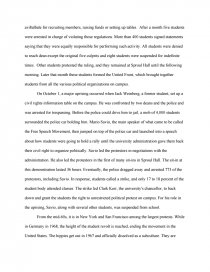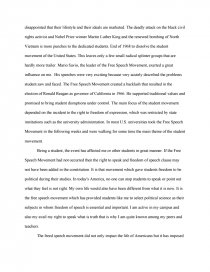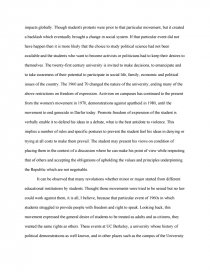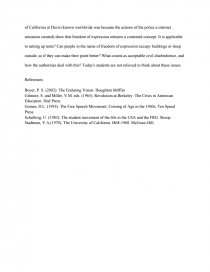1960s: Free Speech Movement
Essay by Kill009 • September 15, 2012 • Essay • 1,477 Words (6 Pages) • 2,551 Views
1960s: Free Speech Movement
[Name of Writer]
[Name of Institution]
1960s: Free Speech Movement
Introduction
Like no other time of the 20th Century depend on the sixties, the image of the reform decade. Important political, cultural and social upheaval took place. This work deals with the impact that these changes in society had on the American life of the sixties. A point comes when dealing with the sixties, however, often into oblivion. It was certainly the decade of protests, the resurrection - but many reforms and changes were only possible because they have been approved by the authorities. In 1960 arose from the movement of Martin Luther King a new group, which was founded as a student, the Student Nonviolent Coordinating Committee. Blacks and whites worked together in this fraternal organization. Initially, the violence started, but already in the summer of 1964 this principle was abandoned.
Discussion
The Free Speech Movement at the University of California at Berkeley sought to protect political and civil rights in the 1960s. It was the first major action in the nationwide student revolution. The University of California had long been a place marked by student activism. In 1936, the students reacted vigorously to the university's policy requiring the approval of its president for off-campus speakers and the use of campus facilities by non-approved groups. The students protested by using flatbed trucks at the university's entrances in order to speak. In 1956, when Democratic presidential candidate Adlai Stevenson was not allowed to speak on campus, he ended up addressing students atop a car parked in a corner of campus.
Further conflict at Berkeley started in September 1964 when the dean of students sent a letter to students to let them know that the sidewalk in front of the campuses is no longer avi8albale for recruiting members, raising funds or setting up tables. After a month five students were arrested in charge of violating those regulations. More than 400 students signed statements saying that they were equally responsible for performing such activity. All students were denied to reach dean except the original five culprits and eight students were suspended for indefinite times. Other students protested the ruling, and they remained at Sproul Hall until the following morning. Later that month these students formed the United Front, which brought together students from all the various political organizations on campus.
On October 1, a major uprising occurred when Jack Weinberg, a former student, set up a civil rights information table on the campus. He was confronted by two deans and the police and was arrested for trespassing. Before the police could drive him to jail, a mob of 4,000 students surrounded the police car holding him. Mario Savio, the main speaker of what came to be called the Free Speech Movement, then jumped on top of the police car and launched into a speech about how students were going to hold a rally until the university administration gave them back their civil right to organize politically. Savio led the protestors in negotiations with the administration. He also led the protestors in the first of many sit-ins in Sproul Hall. The sit-in at this demonstration lasted 36 hours. Eventually, the police dragged away and arrested 773 of the protestors, including Savio. In response, students called a strike, and only 17 to 18 percent of the student body attended classes. The strike led Clark Kerr, the university's chancellor, to back down and grant the students the right to unrestricted political protest on campus. For his role in the uprising, Savio, along with several other students, was suspended from school.
From the mid-60s, it is in New York and San Francisco among the largest protests. While in Germany in 1968, the height of the student revolt is reached, ending the movement in the United States. The hippies get out in 1967 and officially dissolved as a subculture. They are disappointed that their lifestyle and their ideals are marketed. The deadly attack on the black civil rights activist and Nobel Prize winner Martin Luther King and the renewed bombing of North Vietnam is more punches to the dedicated students. End of 1968 to dissolve the student movement of the United States. This leaves only a few small radical splinter groups that are hardly more trailer. Mario Savio, the leader of the Free Speech Movement, exerted a great influence on me. His speeches were very exciting because very acutely
...
...




